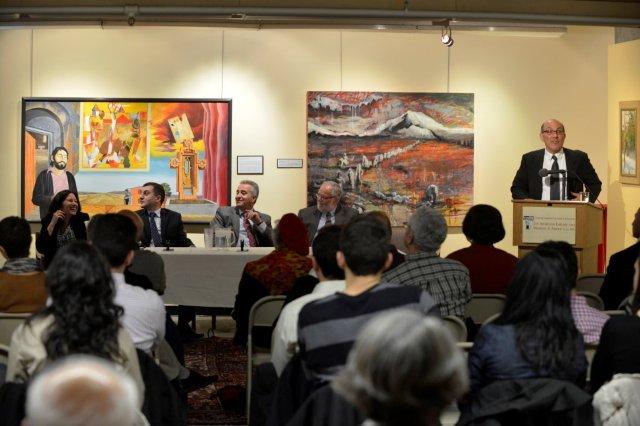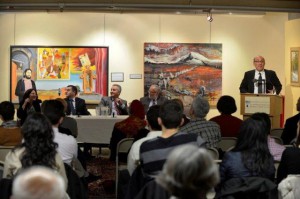
Administrative Team Provides Comprehensive Overview of AUA at ALMA
On Thurs., Nov. 1, members of the American University of Armenia’s (AUA) administrative team provided a comprehensive overview of AUA and its current projects. The lecture, titled “AUA 2013: A Global Education in Armenia,” featured the president of the university, Dr. Bruce Boghosian; Dr. Dennis Leavens, provost; Ashot Ghazaryan, vice president (VP) of operations; Gevorg Goyunyan, VP of finance; and Maral Chalian, VP of institutional advancement.
The presentation began with a historical background on the university, as well as the various degrees that are offered by AUA’s three colleges, the College of Business and Economics, the College of Humanities and Social Sciences, and the College of Science and Engineering. A fourth college, the College of Health and Environmental Sciences, is under discussion.
“The healthcare industry is the largest industry in Armenia, so this degree is very timely,” explained Leavens, in regards to the university’s newest degree, a dual MBA/MPH. Other additions in the fall of 2013 include an undergraduate program with three degrees—English and communication, business, and computational science—and a master’s degree in quantitative economics. The university also projects a four-fold growth in students and a three-fold growth in faculty by 2017.
With the exception of a few courses that are mandated by law to be instructed in Armenian, everything is taught in English. This is crucial, said Boghosian, because a trilingual population would function as “the go-between of the Russian and English-speaking worlds.”
Progress has been made as “graduates emigrate at a much lower level than the general population—even adjusted for demographics, educational levels, etc.,” explained Boghosian. He attributed this to the high level that is set by the university: “The standards by which we measure ourselves are international because that is all that matters.”
AUA has extended its reach not only to Armenian citizens, but to diasporan Armenians and non-Armenians. Also, in recent months, approximately 80 Syrian-Armenian students who sought refuge in Armenia are currently enrolled in AUA, free of charge—with the support of generous donors. Leavens considered the program to be a success. The Syrian-Armenian students, he said, “enrich our campus as much as we try to educate them.”
For more information about the American University of Armenia, visit www.aua.am.

